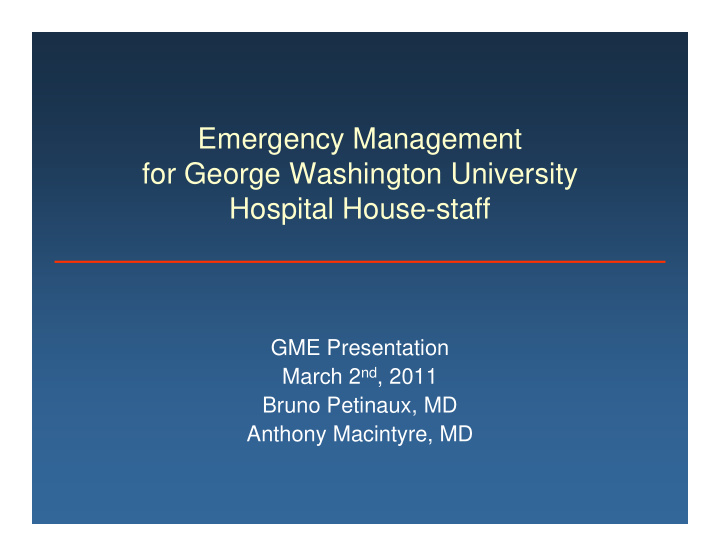



Emergency Management for George Washington University Hospital House-staff GME Presentation March 2 nd , 2011 Bruno Petinaux, MD Anthony Macintyre, MD
Objectives • Develop an understanding for the scope of healthcare “emergency management” • Impart an awareness level of competency related to GW Hospital’s response plans • Understand your role
What emergencies (and disasters) can impact our hospital operations?
The Pentagon: September 11, 2001
Hospitals are “fragile” systems • Large populations, some of which cannot assist themselves • Open 24 hours • Uniquely dependent on: – Infrastructure – Personnel – Supplies
Wednesday, August 8 th , 2007 Only one water main into hospital Hospital GWUH Break
Hazards Vulnerability Analysis (HVA) • A method for identifying priority hazards and our organizational vulnerabilities (and then ranking them for priority action) • For GW Hospital, one hazard that repeatedly surfaces as a major concern: ??????????
GW Hospital Emergency Management Program works to address: • Building occupant emergency procedures • Continuity of operations • Medical surge
Incident recognition - 2004
How else might an “incident” be recognized as occurring?
Who should be notified? You These two individuals can activate Your the Emergency Supervisor Operations Plan (EOP) House Operations Supervisor Administrator on Call
Critical points…………….. • Response procedures are documented in something called the “Emergency Operations Plan” or EOP • “Activating” the EOP can be costly – Full activation – Partial activation • Service unit guidance is available in each department in “red binders”
How will I be notified that something is occurring? • Overhead speaker • Autodialer • Net Presenter • Unit leaders • Employee call in line X-4900
What is my role as a member of the house staff?
Scenario 1: Surge • You are the senior resident on your service. • An overhead page announces: – “FULL Emergency Operations Plan Activation. Medical Surge Incident for incoming patients. Please refer to appropriate portions of the EOP. This is not a drill.”
Scenario 1: Surge • A primary focus is clearing of the ED – Does not mean you have to respond to the ED! • There may be the need to clear/hold other areas (e.g. Operating Rooms) • Geographic teams in ED • Real-time charting decreases in importance • Triage of resources (e.g. diagnostic)
Scenario 1: Surge • Labor pool: if no assignment, report to the labor pool – Hospital auditorium – Surgery staff lounge • Patient discharge area (as needed) • Family assistance area (as needed)
Scenario 1: Surge • After your work is done, you leave the hospital in your white coat. • A reporter approaches you requesting an interview about what just occurred • What do you do?
Scenario 2: Power • You are working on the floors when you notice the lights flicker then go out (there is only power to every 5 th light in the hallways) • What has happened and what do you do? – Work with staff to check your patients! – Minimize consumption of power (e.g. avoid elevator use if possible)
Scenario 2: Power • Issues: – The hospital has 2 back up generators – They do not power everything and cannot provide power indefinitely – Back up power is provided to: • ORs • Interventional labs (USP provides time limited power – need to conclude case!) • Telemetry • Red outlets
Scenario 2: Power • Back up power is not provided to many areas/devices • Limited power to HVAC • Very limited power to radiology • In extreme circumstances, might result in at least a partial hospital evacuation
Scenario 3: Evacuation • A large fire in Foggy Bottom Metro is difficult for DC Fire and EMS to control • Smoke is billowing up from the station and into the hospital • Hospital administration makes the decision to evacuate parts of the hospital
Scenario 3: Evacuation • There are different time frames for evacuation: – Emergent (minutes) – Urgent (hours) – Semi-urgent (days) • This is considered an option of last resort
Scenario 3: Evacuation • Verify the evacuation order • Move any one away from immediate danger • Do not use elevators for personal use • Hospital administration will dictate which patient populations move first • The Labor Pool is typically set up in Himmelfarb Library
Scenario 3: Evacuation • Where do we take patients? – Staging areas outside hospital – Definitive care • Accountability – Clearing a department – Accountability outside of the hospital
Scenario 4: Code Silver • You are working on the floor. • An overhead page announces: – “FULL Emergency Operations Plan Activation. Code Silver, Room 412. This is not a drill.”
Scenario 4: Code Silver • What is this announcement for? • Is this a real threat that a hospital needs to worry about? • What should I do?
Scenario 4: Code Silver • Get out • Spread out • Hide out • Lock out • Follow the directions of responding law enforcement
Other scenarios to be familiar with….. • Tornado warning: – We have had near misses in the past – Response actions are designed to protect patients and staff and/or move them from windows • High Level Protectee – Stay away unless part of direct care of the patient – Do not try to access patient information
Reminders • All persons potentially have a role during a hospital emergency • If you have your ID, your job will be a lot easier • Do not talk to media in an unauthorized fashion • You should not access patient charts that you are not directly involved in the care of
What is NOT your role? • You are not in charge • You should not deploy to an incident scene in an independent fashion
Questions?
Recommend
More recommend